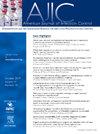分析从新生儿重症监护室患者中分离出的耐甲氧西林金黄色葡萄球菌的毒素产生基因和抗菌基因。
IF 3.8
3区 医学
Q2 INFECTIOUS DISEASES
引用次数: 0
摘要
背景:基于聚合酶链式反应的开放阅读框分型(POT)用于调查耐甲氧西林金黄色葡萄球菌(MRSA)引起的院内感染。我们分析了从新生儿重症监护室患者中分离出的 MRSA 的 POT 类型、院内感染、产毒基因和抗菌基因之间的关系:方法:用 POT 法对 44 株菌株进行了分型。我们鉴定了毒素基因 lukpvSF、tst、eta 和 etb 以及抗菌基因 qacA/B 和 smr:结果:确定了 14 种 POT 类型;43 株菌株被认为是社区获得性 MRSA。28株为医院内感染。有 11 株菌株的产毒基因呈阳性(9 株为 tst 基因,2 株为 lukpvSF 基因),被分为 6 种 POT 类型。六株菌株的抗菌药耐药基因(qacA/B)呈阳性,分为两种 POT 类型。总体而言,有 11 株 MRSA 分离物的毒素产生基因和/或抗菌药耐药基因呈阳性(6 株为非病原性;5 株为非病原性)。POT类型为106-9-80的菌株(两株)和106-221-120的菌株(四株)的tst和qacA/B基因呈阳性,其中本土和非本土菌株各占一半:讨论:某些 POT 类型容易引起院内感染。讨论:某些 POT 类型容易引起院内感染,但在产毒基因或抗菌基因与院内感染之间没有发现明显的关联:结论:除毒素产生和对消毒剂的耐药性外,其他因素也可能与医院内感染有关。本文章由计算机程序翻译,如有差异,请以英文原文为准。
Analysis of toxin-producing and antiseptic resistance genes of methicillin-resistant Staphylococcus aureus isolated from patients in a neonatal intensive care unit
Background
Polymerase chain reaction--based open-reading frame typing (POT) is used to investigate nosocomial infections caused by methicillin-resistant Staphylococcus aureus (MRSA). We analyzed the relationship between POT types, nosocomial infections, and toxin-producing and antiseptic resistance genes of MRSA isolated from patients in neonatal intensive care units.
Methods
Forty-four strains were typed by POT method. We identified toxin genes lukpvSF, tst, eta and etb, and antiseptic resistance genes qacA/B and smr.
Results
Fourteen POT types were identified; 43 strains were considered community-acquired MRSA. Twenty-eight strains were nosocomial. Eleven strains were positive for toxin-producing genes (9 for tst and 2 for lukpvSF) and classified into 6 POT types. Six strains were positive for antiseptic resistance genes (qacA/B) and classified into 2 POT types. Overall, 11 MRSA isolates were positive for toxin-producing or antiseptic resistance genes (6 nosocomial, 5 non-nosocomial). Strains with POT types 106-9-80 (2 strains) and 106-221-120 (4 strains) were positive for tst and qacA/B, equally divided between nosocomial and non-nosocomial.
Discussion
Some POT types are prone to nosocomial infections. However, no clear association between toxin-producing or antiseptic resistance genes and nosocomial infections was observed.
Conclusions
Factors other than toxin production and resistance to disinfectants may be related to nosocomial infection.
求助全文
通过发布文献求助,成功后即可免费获取论文全文。
去求助
来源期刊
CiteScore
7.40
自引率
4.10%
发文量
479
审稿时长
24 days
期刊介绍:
AJIC covers key topics and issues in infection control and epidemiology. Infection control professionals, including physicians, nurses, and epidemiologists, rely on AJIC for peer-reviewed articles covering clinical topics as well as original research. As the official publication of the Association for Professionals in Infection Control and Epidemiology (APIC)

 求助内容:
求助内容: 应助结果提醒方式:
应助结果提醒方式:


